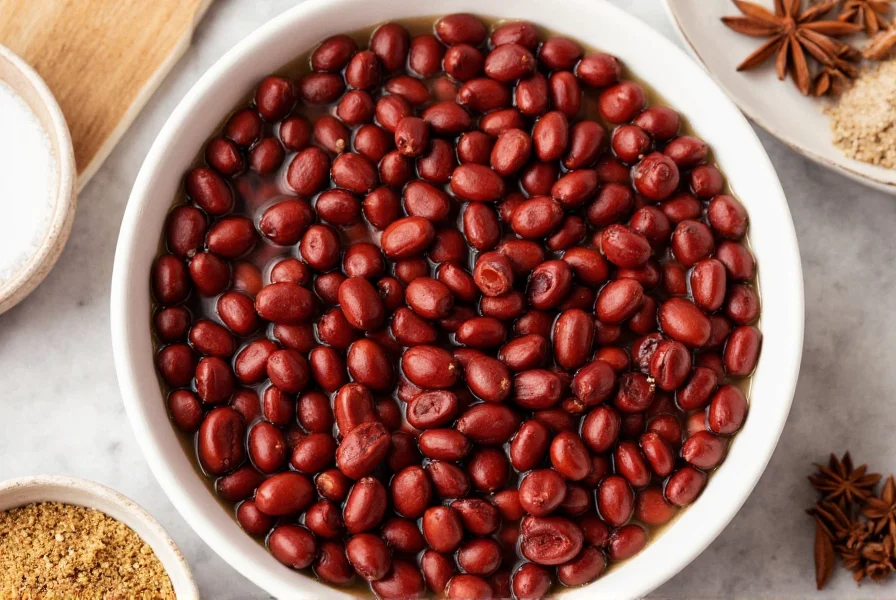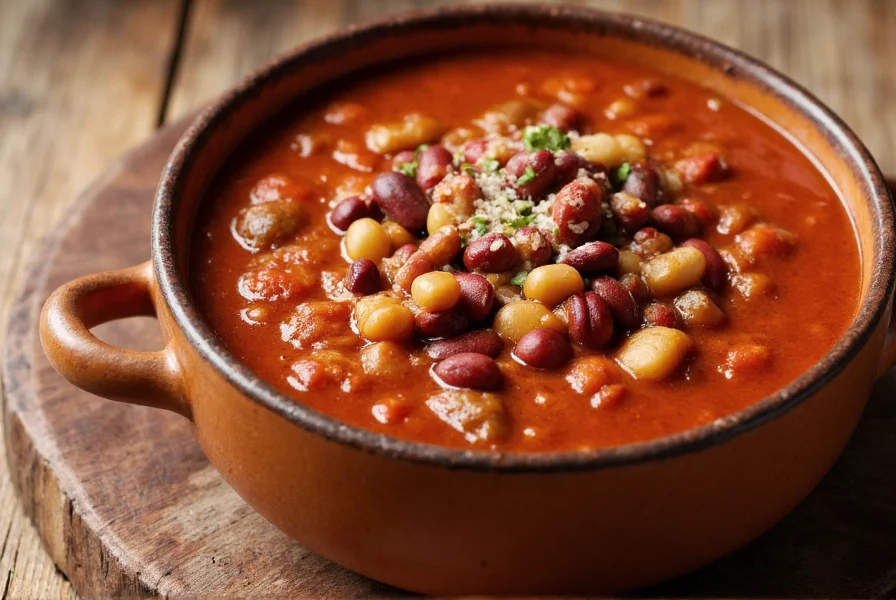Yes, you can absolutely make exceptional chili using dried beans instead of canned. The key advantage is superior texture and deeper flavor control, though it requires proper soaking (8-12 hours) and longer cooking time (1.5-2 hours). Dried beans cost about 60% less than canned and contain no preservatives, but require advance planning. For best results, use kidney or pinto beans, soak overnight, and add them to your chili during the last 45-60 minutes of simmering to maintain ideal texture.
Why Dried Beans Elevate Your Chili
When making chili with dried beans, you're choosing quality over convenience. Professional chefs consistently prefer dried beans for authentic chili because they absorb flavors more effectively and maintain a firmer texture throughout cooking. Unlike canned beans that often turn mushy during extended simmering, properly prepared dried beans hold their shape while developing complex flavors.
The cost savings are substantial too. A one-pound bag of dried beans (about $1.50) yields nearly six cups of cooked beans, equivalent to four cans of beans (costing $3.50-$4.00). This makes dried beans the economical choice for regular chili makers, especially when preparing large batches.
Best Bean Varieties for Chili
Not all dried beans work equally well in chili. Understanding which varieties deliver optimal results prevents disappointing texture and flavor issues.
| Bean Type | Flavor Profile | Texture When Cooked | Best For |
|---|---|---|---|
| Dark Red Kidney | Robust, earthy | Firm, holds shape | Traditional Texas chili |
| Pinto | Mild, nutty | Creamy but intact | Southwestern style chili |
| Black Beans | Earthy, slightly sweet | Firm with thin skin | Modern fusion chili |
| Cranberry (Borlotti) | Sweet, chestnut-like | Creamy interior | White chili variations |
Avoid using delicate beans like navy or great northern in chili—they break down too easily during long cooking. For authentic results, dark red kidney beans remain the gold standard, while pintos offer a slightly milder alternative that still holds up well.

Mastering the Soaking Process
Proper preparation of dried beans is non-negotiable for perfect chili. The soaking process rehydrates beans and reduces cooking time while improving digestibility. Here are three reliable methods:
Overnight Soak Method (Recommended)
Place 1 cup dried beans in a large bowl with 3 cups cold water. Soak at room temperature for 8-12 hours. Drain and rinse before cooking. This traditional method yields the most consistent results and helps reduce compounds that cause digestive discomfort.
Quick Hot Soak Method
For time-pressed cooks, bring beans and water to a boil for 2 minutes, then remove from heat, cover, and let stand for 1 hour. Drain and rinse. While faster, this method produces slightly less uniform results than overnight soaking.
Pressure Cooker No-Soak Method
When using an Instant Pot or pressure cooker, you can skip soaking. Combine 1 cup dried beans with 2.5 cups liquid and cook at high pressure for 25-30 minutes, followed by a natural 15-minute release. This works well but offers less control over final texture.
Regardless of method, always inspect beans for debris and rinse thoroughly before soaking. Never add salt during soaking as it can toughen bean skins.
Perfect Chili with Dried Beans Recipe
This tested recipe yields a rich, complex chili with perfectly textured beans. Plan for 3 hours total time (including soaking).
Ingredients
- 1 cup dried dark red kidney beans (soaked overnight)
- 2 lbs ground chuck or plant-based alternative
- 1 large yellow onion, diced
- 4 cloves garlic, minced
- 2 bell peppers, diced
- 3 tbsp chili powder
- 2 tsp cumin
- 1 tsp smoked paprika
- 1 tsp oregano
- 28 oz crushed tomatoes
- 2 cups beef or vegetable broth
- 2 tbsp tomato paste
- 1-2 chipotle peppers in adobo, minced
- Salt and black pepper to taste
Step-by-Step Instructions
- After soaking, drain and rinse beans thoroughly. Place in large pot with fresh water to cover by 2 inches. Bring to gentle boil, reduce heat, and simmer 30 minutes until partially tender but still firm.
- While beans cook, brown ground meat in large Dutch oven over medium-high heat. Drain excess fat.
- Add onions, garlic, and bell peppers to meat. Cook until vegetables soften (8-10 minutes).
- Stir in chili powder, cumin, paprika, and oregano. Cook 1 minute until fragrant.
- Add crushed tomatoes, broth, tomato paste, and chipotle peppers. Bring to simmer.
- Drain par-cooked beans and add to chili mixture. Simmer uncovered for 45-60 minutes, stirring occasionally, until beans reach desired tenderness and flavors meld.
- Season with salt and pepper. For deeper flavor, refrigerate overnight before serving.

Troubleshooting Common Issues
Even experienced cooks encounter challenges when making chili with dried beans. Here's how to solve frequent problems:
Beans Remain Hard After Cooking
This typically happens with old beans or hard water. Always check your beans' expiration date—beans stored longer than 12 months lose their ability to soften properly. If using hard water, add 1/4 teaspoon baking soda to the soaking water to help break down bean skins.
Chili Too Watery
Dried beans absorb less liquid than canned, so you may need to reduce broth by 25%. If your chili is too thin, simmer uncovered for 15-20 minutes to reduce liquid, or mash some beans against the pot side to naturally thicken the mixture.
Flavor Lacks Depth
When using dried beans, add 1-2 tablespoons of masa harina during the last 30 minutes of cooking. This traditional thickener enhances corn flavor that complements beans beautifully. A splash of apple cider vinegar at the end brightens flavors without making the chili taste acidic.
Advanced Techniques for Exceptional Results
Professional chili makers use these methods to elevate their dried bean chili:
- Layered Cooking: Cook beans separately with aromatics (onion, garlic, bay leaf) before adding to chili base. This prevents bean flavor from being overwhelmed.
- Acid Timing: Add tomatoes and other acidic ingredients only after beans are nearly tender. Acid prevents beans from softening properly if added too early.
- Texture Control: For restaurant-quality texture, remove half the beans after 30 minutes of chili simmering, mash them, then return to pot. This creates natural thickness without losing whole bean texture.
- Freezing Strategy: Chili with dried beans freezes exceptionally well. Cool completely before freezing, and leave beans slightly undercooked in the original batch—they'll finish cooking when reheated.
Frequently Asked Questions
Can I skip soaking dried beans for chili?
Yes, but with trade-offs. Skipping soaking increases cooking time by 30-50% and may result in uneven texture. For best results, use a pressure cooker if you must skip soaking—cook dried beans with chili ingredients at high pressure for 25 minutes followed by natural release.
How much dried beans equals one can of beans?
One cup of dried beans (before soaking) yields approximately 2.5-3 cups of cooked beans, equivalent to two 15-ounce cans of drained beans. When substituting dried for canned in recipes, use half the amount of dried beans by volume before cooking.
Why does my chili with dried beans taste flat?
Dried beans require more seasoning than canned. Increase salt by 25% and add 1/2 teaspoon of sugar to balance acidity. The most common mistake is adding beans too early—add par-cooked beans during the last 45 minutes of simmering to preserve their flavor integrity.
Can I use the soaking water for cooking chili?
No, always drain and rinse soaked beans before cooking. The soaking water contains oligosaccharides that cause digestive discomfort and can create off-flavors. Fresh water ensures cleaner bean flavor that complements rather than competes with your chili spices.
How do I prevent beans from breaking down in chili?
Add beans during the last 45-60 minutes of cooking rather than at the beginning. Maintain a gentle simmer rather than a rolling boil, and avoid stirring vigorously once beans are added. Adding a small amount of baking soda (1/8 teaspoon) to the cooking water can help maintain bean integrity, especially in hard water areas.











 浙公网安备
33010002000092号
浙公网安备
33010002000092号 浙B2-20120091-4
浙B2-20120091-4